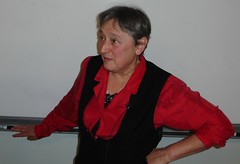 This past Saturday I attended a talk by evolutionary biologist Lynn Margulis at the University of Western Ontario (my alma mater).
This past Saturday I attended a talk by evolutionary biologist Lynn Margulis at the University of Western Ontario (my alma mater).Margulis is known for her work developing symbiogenesis theory -- the idea that organisms come about primarily through the merger of individual and separate organisms.
The talk was attended by about 150 people, mostly profs and grad students. Margulis arrived a little late and looked a bit frazzled from her hectic schedule. She was a bit hoarse and under the weather, but was openly pleased to see a standing room only audience on a rainy Saturday afternoon.
Her presentation was done primarily through PowerPoint, and a number of her videos were accompanied by music; you could tell that some in the audience felt her presentation to be a tad on the "pop-science" side. It was certainly not technical enough for this particular audience, and meant more for undergrads (which was fine by me because I was able to follow most of it). Margulis was also guilty of incessant name dropping, a habit that grew quite tiresome after some time. Some people took early opportunites to leave -- individuals who were probably hoping for something more advanced and informative.
That being said, her presentation did result in some ooohs and aaaahs from the audience, including videos of photosynthetic worms and an equisitely camouflaged octopus.
Margulis, who was significantly influenced by 20th century Russian biologists like Konstantin Mereschkowsky, fleshed out her theory in her 1981 work, In Acquiring Genomes: A Theory of the Origins of Species. In this paper, Margulis argued that symbiogenesis is a primary force in evolution. According to her theory, acquisition and accumulation of random mutations are not sufficient to explain how inherited variations occur. Instead, new organelles, bodies, organs, and species arise from symbiogenesis.
Margulis is also a pioneer in gaia theory. Along with James Lovelock, Margulis has helped to popularize the concept and give it its modern form. Symbiogenesis theory clearly works well within gaianism, as it stresses the need to look at interactions of populations of organisms at given periods of time. During her talk, Margulis stressed the fact that individuals don't evolve but populations do. Her only qualms with Darwinism was that she believes the diversity of life arose not through competition but through organisms networking with each other.
Recent work on the human genome project has certainly added credence to Margulis's claim. During the talk, Dr. Shiva Singh noted that upwards of 41% of the human genome is comprised of viral DNA. Margulis also noted that the human body is not one singular organism. Rather, like the Earth's ecosystem, the human body is a community of life. We have bacteria in our gut and critters on our skin. Without them, we couldn't survive. She noted the case of one individual who lacked the ability to maintain such a balance, and it cost extreme sums of money to keep the person alive before he eventually died.
During her career Margulis has had to consistently defend her ideas against the established brands of evolutionary biology, particularly the likes of Richard Dawkins and other neo-Darwinists. Margulis has also had to work particularly hard as a woman in a field largely dominated by men. She noted how at one time a physicist snidely remarked that her theory of symbiogenesis was something to be expected from a female biologist who would naturally accept processes of co-operation rather than competition.
But during her talk, Margulis dismissed the efficacy of using such terms as co-operation and competition when describing the processes of evolution. "They belong in an economics class or on the basketball court," she said. The actual processes at work, she argued, are far too complex to reduce to such simple "cultural" phrases.
Disappointingly, Margulis's argument was quite weak in regards to explaining the actual mechanisms behind symbiogenesis and the encoding of such information at the genetic level. Nor did she offer much in the way of explaining how these relationships arise amongst populations of organisms so that they become common traits of particular species.
But Margulis certainly got me thinking about the dangers of reductionism and over-specialization when studying the processes of evolution. There are a multitude of mechanisms at work at all levels in the linear and inter-species cycles of evolution and the rise of individual species.
Natural selection, competition, co-operation, parasitism, mutualism, population genetics, fitness peaks, puntuated equilibrium, symbiogenesis, gaia -- it's all good.
Tags: lynn margulis, symbiogenesis, endosymbiotic theory, evolutionary biology, gaia theory.

No comments:
Post a Comment